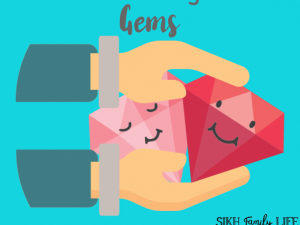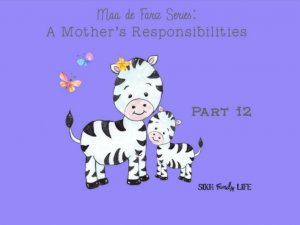Jul 13, 2018 | I know! I know! It goes against what most of us have been taught or believe about Kaljug. So it can be quite the shocker to find out that there are actually quite great benefits to living in this age of Darkness. So in this post, we’ll cover some of the positive aspects of Kaljug.
What is Kaljug? First, I think it’d be helpful to briefly address what exactly we mean when we say ‘Kaljug’? Is it a person? Is it an era? To be totally confusing, but not contradictory (because Sikhi has no contradictions! – it’s perfect!)… Kaljug is both!
To unpack this idea little further, we can look towards Baani that clearly describes Kaljug as an Era. I think that part is pretty easily digestable for most. It’s known as the Age of Darkness. In Asa Di Vaar, Guru Nanak Dev Ji explains succinctly that the state of people in each Jug was largely driven by two factors. Factors varied based on the Yug:
ਨਾਨਕ ਮੇਰੁ ਸਰੀਰ ਕਾ ਇਕੁ ਰਥੁ ਇਕੁ ਰਥਵਾਹੁ ]
naanak mer sareer kaa ik rath ik rathavaahu ||
O Nanak, the soul of the body has one chariot and one charioteer.
ਜੁਗੁ ਜੁਗੁ ਫੇਰਿ ਵਟਾਈਓਹਿ ਗਿਓਾਨੀ ਬੁਝਹਿ ਤਾਹਿ ]
jug jug fer vaTaie’eeh giaanee bujheh taeh ||
In age after age they change; the spiritually wise understand this.
ਸਤਜੁਗਿ ਰਥੁ ਸੰਤੋਖ ਕਾ ਧਰਮੁ ਓਗੈ ਰਥਵਾਹੁ ]
satajug rath sa(n)tokh kaa dharam agai rathavaahu ||
In the Golden Age of Sat Yuga, contentment was the chariot and righteousness the charioteer.
ਤ੍ਰੇਤੈ ਰਥੁ ਜਤੈ ਕਾ ਜੋਰੁ ਓਗੈ ਰਥਵਾਹੁ ]
tretai rath jatai kaa jor agai rathavaahu ||
In the Silver Age of Traytaa Yuga, celibacy (meaning, being in control of the 5 vices) was the chariot and power the charioteer.
ਦੁਓਾਪੁਰਿ ਰਥੁ ਤਪੈ ਕਾ ਸਤੁ ਓਗੈ ਰਥਵਾਹੁ ]
dhuaapur rath tapai kaa sat agai rathavaahu ||
In the Brass Age of Dwaapar Yuga, penance was the chariot and truth the charioteer.
ਕਲਜੁਗਿ ਰਥੁ ਓਗਨਿ ਕਾ ਕੂੜੁ ਓਗੈ ਰਥਵਾਹੁ ]1]
kalajug rath agan kaa kooR agai rathavaahu ||1||
In the Iron Age of Kali Yuga, fire is the chariot and falsehood the charioteer. ||1||
(Raag Asa, Mehla 1, Ang 470)
From this Bani from Guru Nanak Dev Ji, we can see that Kaljug is an era.
However, Kaljug is also an entity. In fact, there’s a Sakhi of when Kaljug actually came to meet Guru Nanak Dev Ji. At first, Kaljug assumed these incredibly scary forms, with these massive teeth, he looked all fiery and essentially, like something out of a horror movie. However, as Kaljug came closer and closer to Baba Nanak, Kaljug started looking more and more human. Once he reached Guru Nanak Dev Ji, he looked exactly like you or me and actually did a Matha Ttek. He had a shawl or blanket that he wrapped around his body. Notably, it had many small holes in it. Bhai Mardana Ji asked Kaljug about what he was wearing, Kaljug explained that it’s his blanket of laziness and sleepiness that he puts over the world at Amrit Vela. The holes are where Gurmukh-Piyaare break through (by waking up) and do Bhajan Bandagi (Bhagti). To learn more about the scoop on Amrit Vela and why it’s so important for Sikhs, read this.
There are two pretty significant things that this Sakhi tells us: 1) Now we know why it’s SO difficult to wake up in the morning for Amrit Vela and 2) the closer we get to Guru Nanak Dev Ji, the more we assume the form of a real human (that is, we begin to display the qualities and character of someone with humanity). This effect is so strong, that even Kaljug was forced to become a real human being upon meeting Guru Nanak Dev Ji.
So, from the above Bani and from the above Sakhi, we can see how Kaljug is not only an era, but also an entity, too.
Now that we’ve gone over the definition of Kaljug, what redeeming qualities does Kaljug have?
YOU reap what YOU sow!
Ever been punished for someone else’s action? Doesn’t feel great, huh? We feel so indignant when this happens – and for good reason, too! We think, “We didn’t do it. Why are we being punished?!”
Well, in Kaljug, one of the biggest plus points is that only the person who is responsible for paap (sin), pays for the paap:
ਜੋ ਫੇੜੈ ਸੋ ਫੜੀਦਾ ਕਲਿਜੁਗ ਸਚਾ ਨਿਓਾਉ ਕਰਾਏ[
jo feRai so faReedhaa kalijug sachaa niaau karaae|
The justice of Kaliyug is true because only he suffers who does the evil deeds.
(Bhai Gurdas Ji’s Vaaran, Pannaa 23)
Bhai Gurdas Ji actually called it an injustice that in the previous jugs (eras), people other than the “offender” (the person committing paap) would get dragged into paying for what one person did:
ਸਤਿਜੁਗੁ ਉਤਮੁ ਓਾਖੀਓੈ ਇਕੁ ਫੇੜੈ ਸਭ ਦੇਸੁ ਦੁਹੇਲਾ[
satijug autam aakheeaai ik feRai sabh dhes dhuhelaa|
Satyuga is said to be best but in it one committed sin and the whole country suffered.
ਤ੍ਰੇਤੈ ਨਗਰੀ ਪੀੜੀਓੈ ਦੁਓਾਪੁਰਿ ਵੰਸੁ ਵਿਧੁੰਸੁ ਕੁਵੇਲਾ[
tretai nagaree peeReeaai dhuaapur va(n)s vidhu(n)s kuvelaa|
In treta, one did the wrong act and the whole city would suffer. In Duapar, sinful act of one person made the whole family suffer.
ਕਲਿਜੁਗਿ ਸਚੁ ਨਿਓਾਉ ਹੈ ਜੋ ਬੀਜੈ ਸੋ ਲੁਣੈ ਇਕੇਲਾ[
kalijug sach niaau hai jo beejai so lunai ikelaa|
The justice of Kaliyuga is true because in it only he reaps who sows the evil seeds.
(Bhai Gurdas Ji’s Vaaran, Pannaa 12)
In these pangtian, Bhai Gurdas Ji describes the divine law of each era. In Satjug, if someone sinned, the whole country suffered. In Treta, the whole city would suffer because of the act of ONE person. In Duapar, the individual’s family would all suffer because of the act of that ONE person. However, in Kaljug, the justice is “true” in that only the person who sows paap, reaps the fruit – the consequences – from that paap.
This is a HUGE plus point of Kaljug: We are responsible for our own actions. This is wonderful, especially since we cannot control the actions of others or change other people. Therefore, the focal point of our energies can be/should be directed inwards towards changing ourselves and bettering ourselves. I believe it was Giani Sant Singh Maskeen Ji who put it beautifully, “You want to better the world? Better yourself, and you’ve just bettered a part of the world.”
Shortend Lifespans – Greater benefit with less effort.
In Kaljug, there’s a shortened lifespan and a LOT of distractions. After all, fire and falsehood are the main distinguishing and driving features of this Age. Guru Maharaj Ji knows this and therefore, if we do what we are supposed to do in life, Jap Naam, then we’re doing the single, most potent activity that can help propel us to achieve our purpose in life. Because this is Kaljug (and not any other of the previous Yugs) don’t need to:
- Renounce the world and live in the forests
- Leave our families at a certain age
- Make pilgrimages at certain times of year (or ever)
- Conduct ritualistic worship
- Visit certain rivers to take cleansing baths (similar to pilgrimages)
- Austere Penance (Tapsiya)
Instead, Guru Ji said that in Kaljug, the ONLY thing that is of use is Naam.
Focus on Naam – Nothing else matters.
In Kaljug, the ONLY thing that goes with us, the action that has the highest ROI (Return on Investment) is Naam:
ਅਬ ਕਲੂ ਆਇਅ ਰੇ ]
ab kaloo aaio re ||
Now, the Dark Age of Kali Yuga has come.
ਇਕੁ ਨਾਮੁ ਬੋਵਹੁ ਬੋਵਹੁ ]
eik naam bovahu bovahu ||
Plant the Naam, the Name of the One Lord.
ਅਨ ਰੂਤਿ ਨਾਹੀ ਨਾਹੀ ]
an root naahee naahee ||
It is not the season to plant other seeds.
ਮਤੁ ਭਰਮਿ ਭੂਲਹੁ ਭੂਲਹੁ
mat bharam bhoolahu bhoolahu ||
Do not wander lost in doubt and delusion.
ਗੁਰ ਮਿਲੇ ਹਰਿ ਪਾਏ ] ਜਿਸੁ ਮਸਤਕਿ ਹੈ ਲੇਖਾ ]
gur mile har paae || jis masatak hai lekhaa ||
One who has such destiny written on his forehead, shall meet with the Guru and find the Lord.
ਮਨ ਰੁਤਿ ਨਾਮ ਰੇ ]
man rut naam re ||
O mortal, this is the season of the Naam.
ਗੁਨ ਕਹੇ ਨਾਨਕ ਹਰਿ ਹਰੇ ਹਰਿ ਹਰੇ ]2]18]
gun kahe naanak har hare har hare ||2||18||
Nanak utters the Glorious Praises of the Lord, Har, Har, Har, Har. ||2||18||
(Raag Basant, Mehla 5, Ang 1185)
Again, in the previous Jugs, people were encouraged to partake in ritualistic worship, in cleansing baths, and going on pilgrimages. However, in Kaljug, these actions can actually fill us with Ego, and therefore drive us further away from our life’s purpose:
ਚਹੁ ਜੁਗਾ ਕਾ ਹੁਣਿ ਨਿਬੇੜਾ ਨਰ ਮਨੁਖਾ ਨੋ ਏਕੁ ਨਿਧਾਨਾ ]
chahu jugaa kaa hun nibeRaa nar manukhaa no ek nidhaanaa ||
Now, this is the essence of the teachings of the four ages: for the human race, the Name of the One Lord is the greatest treasure.
ਜਤੁ ਸੰਜਮ ਤੀਰਥ ਅਨਾ ਜੁਗਾ ਕਾ ਧਰਮੁ ਹੈ ਕਲਿ ਮਹਿ ਕੀਰਤਿ ਹਰਿ ਨਾਮਾ ]2]
jat sa(n)jam teerath onaa jugaa kaa dharam hai kal meh keerat har naamaa ||2||
Celibacy, self-discipline and pilgrimages were the essence of Dharma in those past ages; but in this Dark Age of Kali Yuga, the Praise of the Lord’s Name is the essence of Dharma. ||2||
(Raag Bilaaval, M: 3, Ang 797)
And…
ਕੋਟਿ ਤੀਰਥ ਮਜਨ ਇਸਨਾਨਾ ਇਸੁ ਕਲਿ ਮਹਿ ਮੈਲੁ ਭਰੀਜੈ ]
koT teerath majan isanaanaa is kal meh mail bhareejai ||
Millions of cleansing baths at sacred shrines of pilgrimage only fill the mortal with filth in this Dark Age of Kali Yuga.
ਸਾਧਸੰਗਿ ਜੋ ਹਰਿ ਗੁਣ ਗਾਵੈ ਸੋ ਨਿਰਮਲੁ ਕਰਿ ਲੀਜੈ ]2]
saadhasa(n)g jo har gun gaavai so niramal kar leejai ||2||
One who sings the Glorious Praises of the Lord in the Saadh Sangat, the Company of the Holy, becomes spotlessly pure. ||2||
(Raag Suhee, M: 5, Ang 747)
In fact, there are TONS of places in Gurbani where Guru Sahib Jee reminds us, in various ways, that in Kaljug, we MUST focus on Naam, Kirtan, Simran, etc:
ਕਲਜੁਗ ਮਹਿ ਕੀਰਤਨੁ ਪਰਧਾਨਾ ]
kalajug meh keeratan paradhaanaa ||
In this Dark Age of Kali Yuga, the Kirtan of the Lord’s Praises are most sublime and exalted.
ਗੁਰਮੁਖਿ ਜਪੀਓੈ ਲਾਇ ਧਿਓਾਨਾ ]
guramukh japeeaai lai dhiaanaa ||
Become Gurmukh, chant and focus your meditation.
ਆਪਿ ਤਰੈ ਸਗਲੇ ਕੁਲ ਤਾਰੇ ਹਰਿ ਦਰਗਹ ਪਤਿ ਸਿਉ ਜਾਇਦਾ ]6]
aap tarai sagale kul taare har dharageh pat siau jaidhaa ||6||
You shall save yourself, and save all your generations as well. You shall go to the Court of the Lord with honor. ||6||
(Raag Maroo, M:5, Ang 1075)
Here, Guru Sahib actually tells us that the best, most excellent activity in Kaljug is participating in Keertan and in Saadh Sangat (where Kirtan is sung). I have heard (many times) that each of us acts as our own “hotspot” (if I may) and that when we sit together in Saadh Sangat to do Kirtan or Paath or any other Naam, the benefits we derive from doing the Naam get multiplied by however many people there are listening, singing along, etc. In other words, our signal strength to Connect with Waheguru is THAT much stronger.
You may be wondering where Seva fits into this whole piece – isn’t Seva important too? Of course it is! I think of Seva as a type of Naam, it’s a way of Connecting with Guru and Waheguru through the Sargun Saroop (the visible) form. We reap the most benefit from doing Seva when we also do Other Naam – like Kirtan, Paath, Simran, etc.
To Review…
Ok, so maybe there’s not a whole lot of plus points for Kaljug… but the positives are pretty positive!
- In this age, only the offender reaps the consequences
- With shortened lifespans and more distractions, Guru Ji simplified Dharam for us: Naam
- Naam is the most direct and potent way to get to Waheguru and it’s all we need
Guru Ji actually redefined the lesser ROI activities and revealed to us their True essence: Naam. Because Naam is so powerful, it’s the only activity we truly need to do in Kaljug.
So THERE, even Kaljug has SOME redeeming qualities!
Resources
Giani Pinderpal Singh Jee – Sakhi of Guru Nanak Dev Ji Meeting Kaljug (Punjabi)
Bhai Jugraj Ji from Basics of Sikhi – Was there Sikhi Before Kaljug (English)






